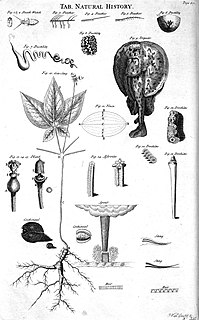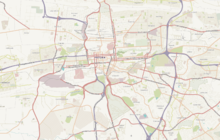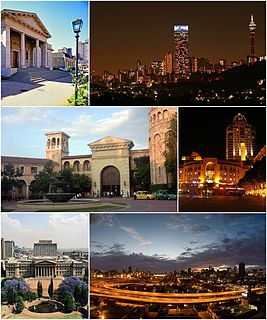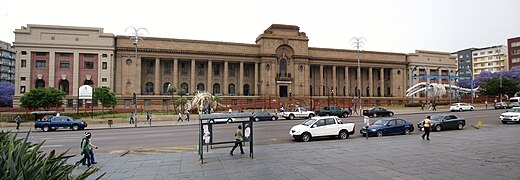
Paranthropus is a genus of extinct hominins that lived between 2.6 and 1.1 million years ago. Also known as robust australopithecines, they were bipedal hominids probably descended from the gracile australopithecine hominids (Australopithecus) 2.7 million years ago.

Robert Broom FRS FRSE was a Scottish South African doctor and paleontologist. He qualified as a medical practitioner in 1895 and received his DSc in 1905 from the University of Glasgow.

Australopithecus is a 'genus' of hominins. From paleontological and archaeological evidence, the genus Australopithecus apparently evolved in eastern Africa around 4 million years ago before spreading throughout the continent and eventually becoming extinct two million years ago. Australopithecus is not literally extinct as the Kenyanthropus, Paranthropus and Homo genera probably emerged as sister of a late Australopithecus species such as A. Africanus and/or A. Sediba. During that time, a number of australopithecine species emerged, including Australopithecus afarensis, A. africanus, A. anamensis, A. bahrelghazali, A. deyiremeda (proposed), A. garhi, and A. sediba.
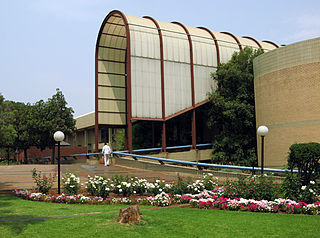
The African Window is a building in Pretoria, Gauteng, which houses the Ditsong National Museum of Cultural History (DNMCH) of South Africa. The DNMCH was amalgamated with the Pretoria-based Transvaal Museum for Natural History (now the Ditsong National Museum of Natural History and the South African National Museum of Military History (now the Ditsong National Museum of Military History on 1 April 1999 to form the Northern Flagship Institution. In April 2010 the new name was launched, and the NFI became Ditsong Museums of South Africa. Ditsong is managed by a chief executive officer and a board, which replaced the three separate previous museum boards.

The Cradle of Humankind is a paleoanthropological site about 50 km (31 mi) northwest of Johannesburg, South Africa, in the Gauteng province. Declared a World Heritage site by UNESCO in 1999, the site currently occupies 47,000 hectares (180 sq mi) and contains a complex of limestone caves. The registered name of the site in the list of World Heritage sites is Fossil Hominid Sites of South Africa.

Mrs. Ples is the popular nickname for the most complete skull of an Australopithecus africanus ever found in South Africa. Many Australopithecus fossils have been found near Sterkfontein, about 40 kilometres (25 mi) northwest of Johannesburg, in a region of the Transvaal now designated as the Cradle of Humankind World Heritage Site. Mrs. Ples was discovered by Robert Broom and John T. Robinson on April 18, 1947. Because of Broom's use of dynamite and pickaxe while excavating, Mrs. Ples's skull was blown into two pieces and some fragments are missing. Nonetheless, Mrs./Mr. Ples is one of the most perfect pre-human skulls ever found. The skull is currently archived at the Ditsong National Museum of Natural History in Pretoria.

The National Zoological Gardens of South Africa is an 85-hectare (210-acre) zoo located in Pretoria, South Africa. It is the national zoo of South Africa, and was founded by J. W. B. Gunning in 1899. Pretoria Zoo is one of the eight largest zoos in the world and one of the most highly-rated.

Australopithecus africanus is an extinct (fossil) species of the australopithecines, the first of an early ape-form species to be classified as hominin. Recently it was dated as living between 3.3 and 2.1 million years ago, or in the late Pliocene and early Pleistocene times; it is debated as being a direct ancestor of modern humans. A. africanus was of slender, or gracile, build and has been found only in southern Africa at four sites: Taung (1924), Sterkfontein (1935), Makapansgat (1948) and Gladysvale (1992).
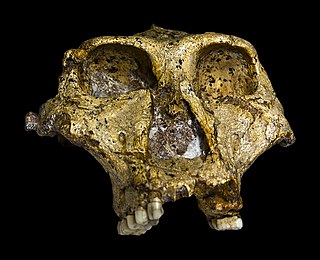
Paranthropus robustus is an early hominin, originally discovered in Southern Africa in 1938. Particularly regarding cranial features, the development of P. robustus seemed to be in the direction of a "heavy-chewing complex". On account of the definitive traits associated with this "robust" line of australopithecine, anthropologist Robert Broom established the genus Paranthropus and placed this species in it.

Transvaal University College was a multi-campus public research university in South Africa which gave rise to the University of the Witwatersrand and the University of Pretoria.

Gladysvale Cave is a fossil-bearing breccia filled cave located about 13 kilometres (8.1 mi) northeast of the well-known South African hominid-bearing sites of Sterkfontein and Swartkrans and about 45 kilometres (28 mi) north-northwest of Johannesburg, South Africa. It is situated within the Cradle of Humankind World Heritage Site and is itself a South African National Heritage Site.

The University of Pretoria is a multi-campus public research university in Pretoria, the administrative and de facto capital of South Africa. The university was established in 1908 as the Pretoria campus of the Johannesburg-based Transvaal University College and is the fourth South African institution in continuous operation to be awarded university status. The university has grown from the original 32 students in a single late Victorian house to approximately 39,000 in 2010. The University was built on 7 suburban campuses on 1,120 hectares.

Australopithecus sediba is a species of Australopithecus of the early Pleistocene, identified based on fossil remains dated to about 2 million years ago. The species is known from six skeletons discovered in the Malapa Fossil Site at the Cradle of Humankind World Heritage Site in South Africa, including a juvenile male, an adult female, an adult male, and three infants. The fossils were found together at the bottom of the Malapa Cave, where they apparently fell to their death, and have been dated to between 1.980 and 1.977 million years ago.
The following is a timeline of the history of Pretoria, in the City of Tshwane Metropolitan Municipality, Gauteng province, South Africa.

Ditsong Museums is an amalgamation of eight museums in the Pretoria and Johannesburg environs in the Gauteng Province. The museums "have diverse collections covering the fields of fauna and flora, palaeontology, military history, cultural history, geology, anthropology and archaeology."
Ina Plug is a South African archaeozoologist, and teacher. Her long career included field research and in museums such as Transvaal Museum and for the University of Pretoria on southern African mammals, starting with the animals from Iron Age sites at the Kruger National Park. Her work resulted in her publishing 130 scientific papers mostly on the skeletal remains of animals. She also published a book titled What Bone Is That? A Guide to the Identification of Southern African Mammal Bones.
John Talbot Robinson was a distinguished South African hominin paleontologist. His most famous discovery was the nearly complete fossil skull of the hominin species Australopithecus africanus, known as Mrs. Ples.

